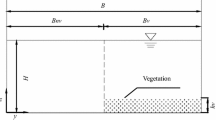Abstract
In combination with a channel bed, suspended vegetationin an open channel can alter flow structure and generate vertically asymmetric flow. This study investigated the mean flow and turbulence structure of an open channel with suspended vegetation through theoretical analysis and laboratory experiments. Three patterns of bionic leaves with different roughness were adopted to imitate suspended vegetation, and three-dimensional velocity field was measured by using an acoustic Doppler velocimeter. The measured data showed that the vertical profile of streamwise velocity obeys a two-power law and that the maximum velocity at the middle depth is close to the smooth boundary (i.e., the channel bed in the experiment) under the combined action of vegetation cover and channel bed. Shear stress is linearly distributed along the vertical axis, and the vertical profile of turbulence intensity obeys an exponential law. Then, a two-power law expression was adopted to predict the vertical profile of streamwise velocity. Theoretical models for the vertical distribution of shear stress and turbulence intensity were also established. The predicted results validated by measurements showed that the different magnitudes of vegetation cover and channel bed boundary roughness exert an obvious impact on flow structure.
Similar content being viewed by others
References
Nepf H. M. Hydrodynamics of vegetated channels [J]. Journal of Hydraulic Research, 2012, 50(3): 262–279.
Zhang X, Nepf H. M. Exchange flow between open water and floating vegetation [J]. Environmental Fluid Mechanics, 2011, 11(5): 531–546.
Hubbard R. K., Gascho G. J., Newton G. L. Use of floating vegetation to remove nutrients from swine lagoon wastewater [J]. Transactions of the ASAE, 2004, 47(6): 1963.
Padial A. A., Thomaz S. M., Agostinho A. A. Effects of structural heterogeneity provided by the floating macrophyte Eichhornia azurea on the predation efficiency and habitat use of the small Neotropical fish Moenkhausia sanctaefilomenae [J]. Hydrobiologia, 2009, 624(1): 161–170.
Rowinski P. M., Kubrak J. A mixing-length model for predicting vertical velocity distribution in flows through emergent vegetation [J]. Hydrological Sciences Journal, 2002, 47(6): 893–904.
Lightbody A. F., Nepf H. M. Prediction of velocity profiles and longitudinal dispersion in salt marsh vegetation [J]. Limnology and oceanography, 2006, 51(1): 218–228.
Yang W., Choi S. U. A two-layer approach for depth-limited open-channel flows with submerged vegetation [J]. Journal of Hydraulic Research, 2010, 48(4): 466–475.
Wang W., Huai W., Gao M. Numerical investigation of flow through vegetated multi-stage compound channel [J]. Journal of Hydrodynamics, 2014, 26(3): 467–473.
Wang W., Peng W., Huai W. et al. Roughness height of submerged vegetation in flow based on spatial structure [J]. Journal of Hydrodynamics, 2018, 30(4): 754–757.
Huai W., Zhang J., Katul G. G. et al. The structure of turbulent flow through submerged flexible vegetation [J]. Journal of Hydrodynamics, 2019, 31(2): 274–292.
Plew D. R., Spigel R. H., Stevens C. L. et al. Stratified flow interactions with a suspended canopy [J]. Environmental Fluid Mechanics, 2006, 6(6): 519–539.
Plew D. R. Depth-averaged drag coefficient for modeling flow through suspended canopies [J]. Journal of Hydraulic Engineering, ASCE, 2010, 137(2): 234–247.
Huai W., Hu Y., Zeng Y. et al. Velocity distribution for open channel flows with suspended vegetation [J]. Advances in Water Resources, 2012, 49: 56–61.
Downing-Kunz M. A., Stacey M. T. Flow-induced forces on free-floating macrophytes [J]. Hydrobiologia, 2011, 671(1): 121–135.
Downing-Kunz M. A., Stacey M. T. Observations of mean and turbulent flow structure in a free-floating macrophyte root canopy [J]. Limnology and Oceanography: Fluids and Environments, 2012, 2(1): 67–79.
O’Donncha F., Hartnett M., Plew D. R. Parameterizing suspended canopy effects in a three-dimensional hydrodynamic model [J]. Journal of Hydraulic Research, 2015, 53(6): 714–727.
Liu Z., Chen Y., Wu Y. et al. Simulation of exchange flow between open water and floating vegetation using a modified RNG k-ε turbulence model [J]. Environmental Fluid Mechanics, 2017, 17(2): 355–372.
Zhao F., Huai W., Li D. Numerical modeling of open channel flow with suspended canopy [J]. Advances in Water Resources, 2017, 105: 132–143.
Han L., Zeng Y., Chen L. et al. Modeling streamwise velocity and boundary shear stress of vegetation-covered flow [J]. Ecological Indicators, 2018, 92: 379–387.
Parthasarathy R. N., Muste M. Velocity measurements in asymmetric turbulent channel flows [J]. Journal of Hydraulic Engineering, ASCE, 1994, 120(9): 1000–1020.
Zare S. G. A., Moore S. A., Rennie C. D. et al. Estimation of composite hydraulic resistance in ice-covered alluvial streams [J]. Water Resources Research, 2016, 52(2): 1306–1327.
Peters M., Dow K., Clark S. P. et al. Experimental investigation of the flow characteristics beneath partial ice covers [J]. Cold Regions Science and Technology, 2017, 142: 69–78.
Tsai W. F., Ettema R. Modified eddy viscosity model in fully developed asymmetric channel flows [J]. Journal of Engineering Mechanics, 1994, 120(4): 720–732.
Papanicolaou A. N., Elhakeem M., Hilldale R. Secondary current effects on cohesive river bank erosion [J]. Water Resources Research, 2007, 43(431): 497–507.
Chen G., Gu S., Huai W. et al. Boundary shear stress in rectangular ice-covered channels [J]. Journal of Hydraulic Engineering, ASCE, 2015, 141(6): 06015005.
Nezu I., Rodi W. Open-channel flow measurements with a laser Doppler anemometer [J]. Journal of Hydraulic Engineering, ASCE, 1986, 112(5): 335–355.
Bonakdari H., Larrarte F., Lassabatere L. et al. Turbulent velocity profile in fully-developed open channel flows [J]. Environmental Fluid Mechanics, 2008, 8(1): 1–17.
Teal M. J., Ettema R., Walker J. F. Estimation of mean flow velocity in ice-covered channels [J]. Journal of Hydraulic Engineering, ASCE, 1994, 120(12): 1385–1400.
Acknowledgements
This work was supported by the CRSRI Open Research Program (Program SN: CKWV2017503/KY), Hubei Natural Science Foundation (Grant No. 2018CFA010) and the CAS Interdisciplinary Innovation Team, and 111 Project (Grant No. B18037).
Author information
Authors and Affiliations
Corresponding author
Additional information
Project supported by the National Natural Science Foundation of China (Grant Nos. 51879197, 51622905 and 51439007).
Rights and permissions
About this article
Cite this article
Li, Q., Zeng, Yh. & Bai, Y. Mean flow and turbulence structure of open channel flow with suspended vegetation. J Hydrodyn 32, 314–325 (2020). https://doi.org/10.1007/s42241-020-0020-6
Received:
Revised:
Accepted:
Published:
Issue Date:
DOI: https://doi.org/10.1007/s42241-020-0020-6



